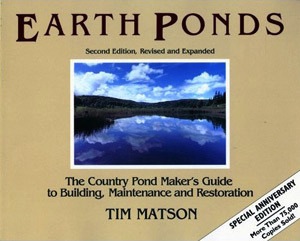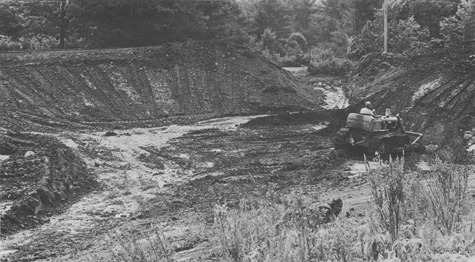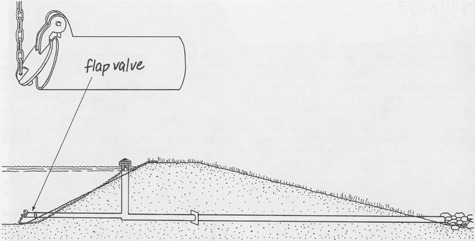*
Fixing low-tide ponds begins with a search for leakage. Ponds with piping often leak around the outside of the pipe or through seams, gaskets, and valves. In most cases, unless a fitting can be easily replaced, pipe repair involves digging up the line to repair joints or to implant anti-seep collars.
*
Tim Matson is the established guru of building ponds with an earth-seal, rather than with a plastic or concrete lining. For 30 years he's been creating, advising, and collecting knowledge about pond-making. His classic Earth Ponds (2nd ed.) is the basic how-to, and comes with a DVD. It supplies the needed lessons in siting a pond, building it, maintaining it, enjoying it, and also restoring old ponds. This is not your average how-to; it's beautifully written and a joy to read. If you find the basics to your liking and need more, Matson has an updated Sourcebook with plenty of resources, and an illustrated encyclopedia of pond variations and building techniques. Finally, Matson has a helpful website with more videos and sources.
Earth Ponds: The Country Pond Maker's Guide to Building, Maintenance and Restoration
Sample Excerpts:

 Ponds can be used for swimming, wildlife magnets, irrigation, iceskating, fire protection coach factory outlet, water gardening, landscaping, and fishing. You can build your own pond in your backyard, farm, or wherever.
Ponds can be used for swimming, wildlife magnets, irrigation, iceskating, fire protection coach factory outlet, water gardening, landscaping, and fishing. You can build your own pond in your backyard, farm, or wherever.


--KK
*
*
Know of a better tool, or need a recommendation? Submit a review or request!
Scraping bottom in the pond basin Ray searches for flaws in the earth seal--clusters of pervious stone or gravel that would be the source of potential leaks. He carves out these patches and substitutes watertight soil. A good seal is the best defense against seepage. Pond makers who claim they can waterproof impossible sites with chemical additives and underwater dynamite blasts should run out of town. Like a potter's bowl, the earth pond is molded with a blend of materials. In addition to drawing a sufficient supply of water, this site consists of good watertight soil: about 10 to 20 percent clay and an even mix of silt, sand, and gravel. Preliminary test holes in the pond basin are crucial in evaluating the worthiness of a site.
The sand drop is another well-esteemed pond keeper's trick that takes advantage of the ice deck. It's an upkeep technique well suited to older ponds in need of restoration, particularly where aquatic vegetation or mud get unruly. To set up a sand drop, the pond keeper spreads a two-to-four inch layer of sand--not salted road sand--over the ice. In spring when the ice thaws, poof! The sand falls in a uniform layer over the basin floor. Sand works like an inorganic mulch, shading out weeds and, like the finings in a beer crock, holding down sediment. In muddy ponds, it's a good carpet material for the basin floor. One of my neighbors was able to use a sand drop to eliminate the slimy bottom in her family's pond, along with snakes and leeches. True, the sand drop does fill in the pond to a minute degree, but it's not often done, and it sure beats herbicides.
Cool Tools at 8:09 am Tuesday, May 22Trout have a reputation as fussy feeders, picky as spoiled Siamese cats; yet for three years I've watched my brook trout gain weight without an ounce of supplemental feed. I see them feast on the bottom as much as in the air: the water is as transparent as an aquarium. I recall my neighbor's drawdown and follow-up trout stocking: clearly, the fish were pitching in to keep it clean. And I recalled an old Vermont tradition: to keep the farmhouse water clean, a trout was dropped in the well.
http://coachfactorystore-bag.weebly.com
没有评论:
发表评论